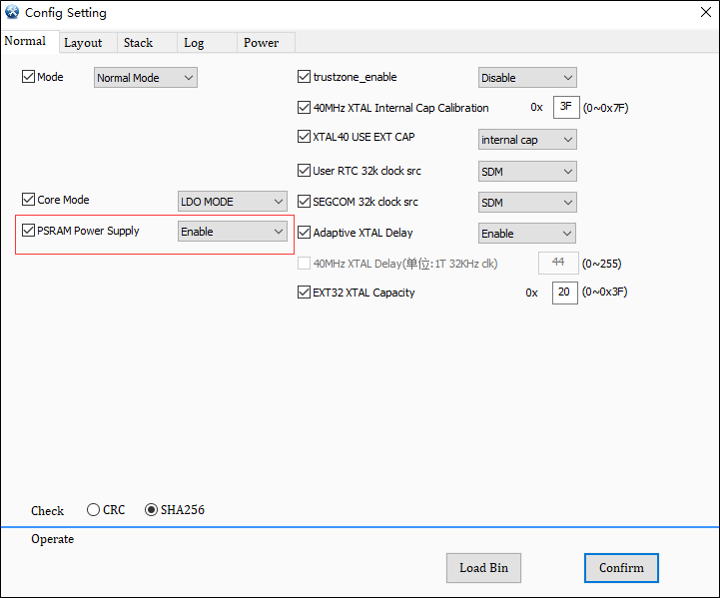PSRAM
PSRAM is a memory type that combines the advantages of DRAM and SRAM, with the ease of use of SRAM and the cost-effectiveness of DRAM. Compared to SRAM, PSRAM is slightly slower but has lower cost and power consumption; compared to Flash, PSRAM is faster but lacks non-volatility.
PSRAM is suitable for scenarios requiring relatively fast storage speeds. Currently, RTL87x2G cannot use external PSRAM, however, some models of the RTL87x2G series feature MCM PSRAM with the model number W955D8MKY. When using it, developers can refer to the datasheet of the corresponding model of RTL876x2G to confirm whether PSRAM is supported. The following text introduces the usage of PSRAM.
Initialization
-
Setting the power-on option for PSRAM in config file. When PSRAM Power Supply is set to Enable, it will internally supply 1.8V power to the PSRAM. Otherwise, the PSRAM will be in a power-off state, consuming no power.

Config File Setting
Defining the macro
USE_PSRAM(#define USE_PSRAM 1) inmem_config.hwill automatically invoke thepsram_winbond_opi_init()to complete the initialization settings for PSRAM.
Switch to High-speed Clock
-
After initialization, the default PSRAM clock is set to 20MHz. Developers can invoke the function
fmc_psram_clock_switch()to switch the PSRAM clock. It is generally recommended to directly switch to PSRAM 80MHz. Details and examples are as follows:Function Name
fmc_psram_clock_switch
Function Prototype
bool fmc_psram_clock_switch(PSRAM_IDX_TYPE idx, uint32_t required_mhz, uint32_t *actual_mhz)
Function Description
set PSRAM clock
Input Parameter
required_mhz: twice the target speed of PSRAM clock (maximum setting is 160MHz, corresponding to 80MHz for PSRAM
actual_mhz: return the actual switched value, where actual_mhz equals required_mhz in the case of a successful clock switch
Prerequisite
None
uint32_t actual_mhz; fmc_psram_clock_switch(PSRAM_IDX_SPIC1, 160, &actual_mhz);
Read and Write Operations
The method of reading and writing PSRAM is the same as that for SRAM, where direct access to PSRAM addresses (using functions like memcpy and memset) is used without the need for a driver. Here is an example:
#define PSRAM_ADDR 0x08000000
#define TEST_ADDR 0x00100000
memcpy((uint8_t *) PSRAM_ADDR, (uint8_t *) TEST_ADDR, 1024); // write
Note
The PSRAM model only supports W955D8MKY, with a starting address of 0x8000000 and a size of 4MB.
Low Power Mode Setting
PSRAM offers two low power modes:
-
DPD (Deep Power Down) modeIf using DPD mode, all content in PSRAM will be lost when entering system low power mode (DLPS).
-
Hybrid Sleep modeIf Hybrid Sleep mode is used, developers can select parts of the PSRAM to retain, and Power Consumption Data will be relatively increased.
For developer convenience, the low power settings for PSRAM are integrated into the system's low power mode. Developers can modify the following two sections to select the desired PSRAM low power mode.
Add #define USE_PSRAM_DEEP_POWER_HALF_SLEEP_MODE 1 in
io_dlps.cto select the Hybrid Sleep mode; otherwise, the DPD mode will be used.-
If developers select the Hybrid Sleep mode, they can modify the second parameter of the function
fmc_psram_wb_set_partial_refresh()inio_dlps.cto choose the region where the content is not lost after entering system low power mode.Function Name
fmc_psram_wb_set_partial_refresh
Function Prototype
bool fmc_psram_wb_set_partial_refresh(FMC_FLASH_NOR_IDX_TYPE idx, FMC_PSRAM_WB_PARTIAL_ARRAY_REFRESH partial)
Function Description
Configure certain regions of PSRAM to retain their content after entering and exiting low-power mode
Input Parameter
FMC_FLASH_NOR_IDX_TYPE: the default value is FMC FLASH NOR IDX1.
FMC_PSRAM_WB_PARTIAL_ARRAY_REFRESH: the following values can be set.
FMC_PSRAM_WB_REFRESH_FULL
FMC_PSRAM_WB_REFRESH_BOTTOM_1_2
FMC_PSRAM_WB_REFRESH_BOTTOM_1_4
FMC_PSRAM_WB_REFRESH_BOTTOM_1_8
FMC_PSRAM_WB_REFRESH_TOP_1_2
FMC_PSRAM_WB_REFRESH_TOP_1_4
FMC_PSRAM_WB_REFRESH_TOP_1_8
Prerequisite
None
Note
The larger region retention, the higher Power Consumption Data.
Example usage: (In the example, Hybrid Sleep mode is selected, and the PSRAM retention area is the second half of the region)
#define USE_PSRAM_DEEP_POWER_HALF_SLEEP_MODE 1 #if USE_PSRAM #if USE_PSRAM_DEEP_POWER_HALF_SLEEP_MODE fmc_psram_wb_set_partial_refresh(FMC_FLASH_NOR_IDX1, FMC_PSRAM_WB_REFRESH_TOP_1_2); fmc_psram_enter_lpm(FMC_FLASH_NOR_IDX1, FMC_PSRAM_LPM_HALF_SLEEP_MODE); #else fmc_psram_enter_lpm(FMC_FLASH_NOR_IDX1, FMC_PSRAM_LPM_DEEP_POWER_DOWN_MODE); #endif #else shut_down_spic_pad_imp(FMC_FLASH_NOR_IDX1, true); #endif
Power Consumption Data
The power consumption data for W955D8MKY is shown in the following table, with a working voltage of 1.8 V.
Power Consumption Data Power mode
Retention region
Current (uA)
Hybrid Sleep mode
Full Array
20
Bottom 1/2 Array
18
Bottom 1/4 Array
16
Bottom 1/8 Array
15
Top 1/2 Array
18
Top 1/4 Array
16
Top 1/8 Array
15
Deep power down mode
0~0.2
See Also
Please refer to the relevant API Reference: